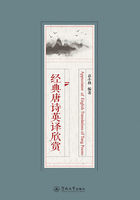
22.咏柳
碧玉妆成一树高,万条垂下绿丝绦。
不知细叶谁裁出,二月春风似剪刀。
中文解读
这是一首咏物诗,描写的是早春二月的杨柳。诗中把杨柳比作婀娜的美女,形象地描绘出枝条细柔修长的杨柳摇摆于春风之中的迷人姿态。二月的春风被诗人比喻成一把剪刀,细细地剪裁出了那些嫩绿的柳叶。
“碧玉妆成一树高,万条垂下绿丝绦”,深深地抓住了垂柳的特征,在诗人的眼中,它是美女的化身。高高的树干,就像她亭亭玉立的风姿,下垂的柳条,就像她裙摆上的丝带。在这里,柳就是人,人就是柳,两者之间仿佛没有什么区别。而且“碧玉”也有双关的意义,既在字面上与柳树的翠色相合,又指年轻貌美的少女,与下面的“二月春风”恰相呼应——这是早春的垂柳,还未到夏秋之际亭亭如盖、树荫清圆的时候。然而,更妙的是以下两句:“不知细叶谁裁出,二月春风似剪刀。”
在贺知章之前,有谁想过春风像剪刀?把乍暖还寒的二月春风由无形化为有形,它显示了春风的神奇灵巧,并使《咏柳》成为咏物诗的典范之作。
白话译文
高高的柳树长满了翠绿的新叶,轻柔的柳枝垂下来,就像万条轻轻飘动的绿丝带。
这细细的嫩叶是谁的巧手裁剪出的呢?原来是那二月里温暖的春风,它就像一把灵巧的剪刀。
英译一
Willow Trees
Translated by Xu Yuanchong
Ten thousand branches of tall trees begin to sprout,
They droop like fringes of a robe made of green jade.
But do you know by whom these young leaves are cut out?
The early spring wind is as sharp as scissor blade.
(droop v.下垂 fringe n.穗;边缘 blade n.刀片)
英译二
Ode to the Willow
Translated by Zhao Yanchun
The tree's dressed with jade green from high to low,
Ten thousand twigs sway down their silky sheen.
Who's tailored the leaves so thin, I don't know,
The second month wind seems like scissors keen.
(twig n.嫩枝 silky adj.柔滑的,丝的 sheen n.光泽keen adj.渴望的;热心的)
英译三
Ode to Willows
Translated by Wu Xinjian
The willow tree is dressed in green jade,
Branches droop like many a silk braid.
Who has cut out the leaves so slender?
Breeze in early spring is a handy tailor.
(braid n.穗带;发辫 breeze n.微风)
英译欣赏
Willow trees shoot its tender leaves in early spring.In the poet's eyes, the trees are like green jade, and leaves are like fringes of a robe. But who has cut out such young leaves like a magician? He gives an answer which people may all like and appreciate.
贺知章用神奇的想象、新鲜的比喻,把绿柳比作碧玉,把柳条比作丝绦,把春风比作剪刀,生动地写出了柳树嫩绿轻柔的风采和春风润万物的功能。
原诗为aaba押韵,译文一、二的韵式作了改变,采用abab 押韵。英译一北京大学许渊冲教授主要用意译,英译二赵彦春(天津外国语大学教授)则用直译,各有特色。
英译一:Ten thousand branches of tall trees begin to sprout, They droop like fringes of a robe made of green jade,先将第二句译出,第一句后出,但语句流畅,很好地表达出了原诗的意义。
“不知细叶谁裁出”:But do you know by whom these young leaves are cut out? Do you know是主句,by whom引导的是宾语从句,英文地道流畅。
The early spring wind is as sharp as scissor blade,这里“似剪刀”译成as sharp as scissor blade,像剪刀一样锋利。
英译二采用对等直译:The tree's dressed with jade green from high to low, Ten thousand twigs sway down their silky sheen, “妆成”直译为:be dressed with(好像人着装一样)。但“不知细叶谁裁出”,译成:Who's tailored the leaves so thin, I don't know,我不知是谁把柳叶剪裁得这么细。把tailor用作动词:剪裁,贴近原句。但把“二月”译成the second month,似不恰当。中国古代(农历)的二月,相当今天(公历)的三四月,似乎意译为early spring更好一些。
网上有很多诗歌翻译爱好者翻译此诗,有些译文非常不错。英译三是知名网友无心剑的翻译,有两个译本。这里选其一,采用aabb押韵,节奏分明,形式与原诗对应,是最简洁的译文,值得欣赏。
The willow tree is dressed in green jade, Branches droop like many a silk braid,柳树就像穿着碧玉一样,枝条像无数的穗带垂着。
Who has cut out the leaves so slender? Breeze in early spring is a handy tailor,谁把叶子剪裁得这么苗条?早春的微风就是那巧手的裁缝。
思考
“似剪刀”这种比喻,英文有as. . . as和like两种翻译,哪种译法更能表达原意?